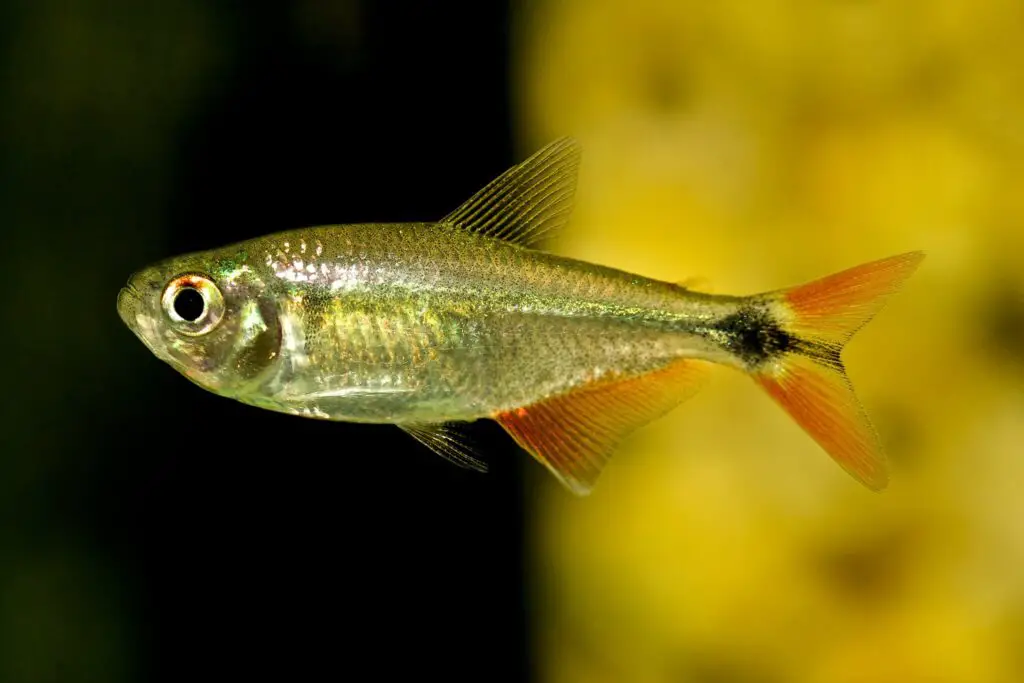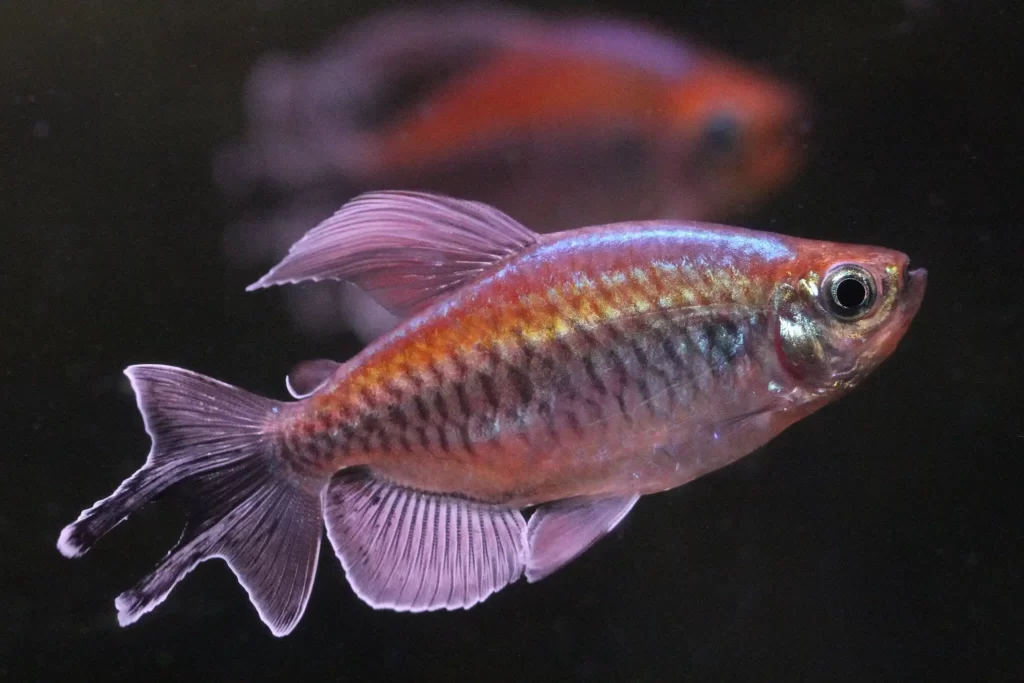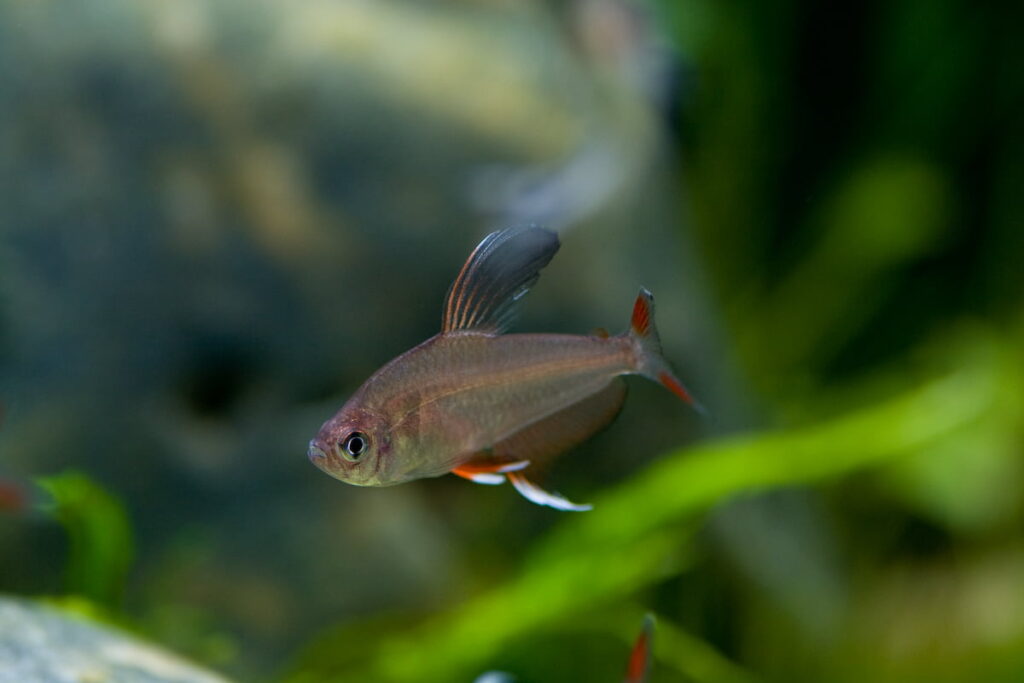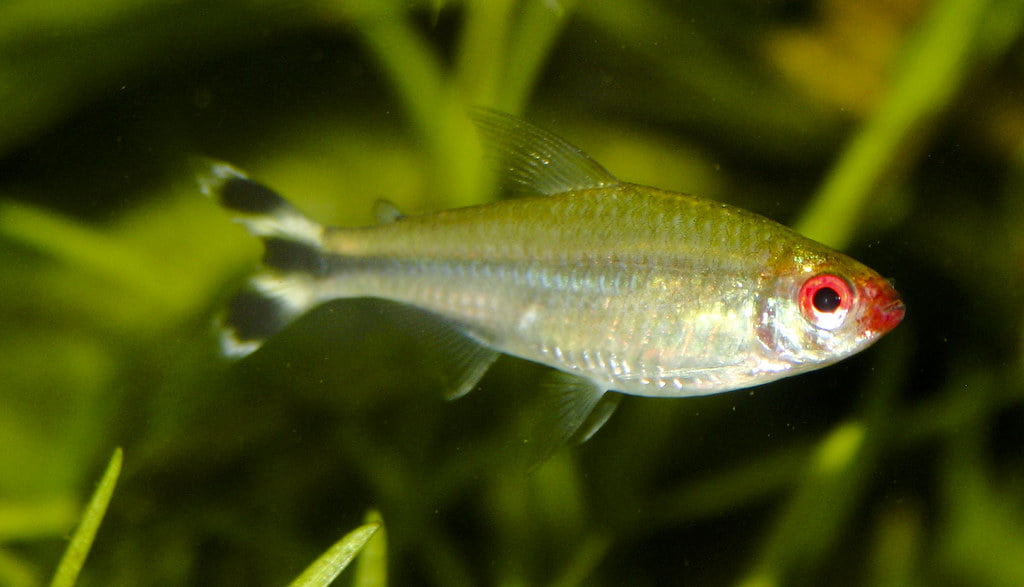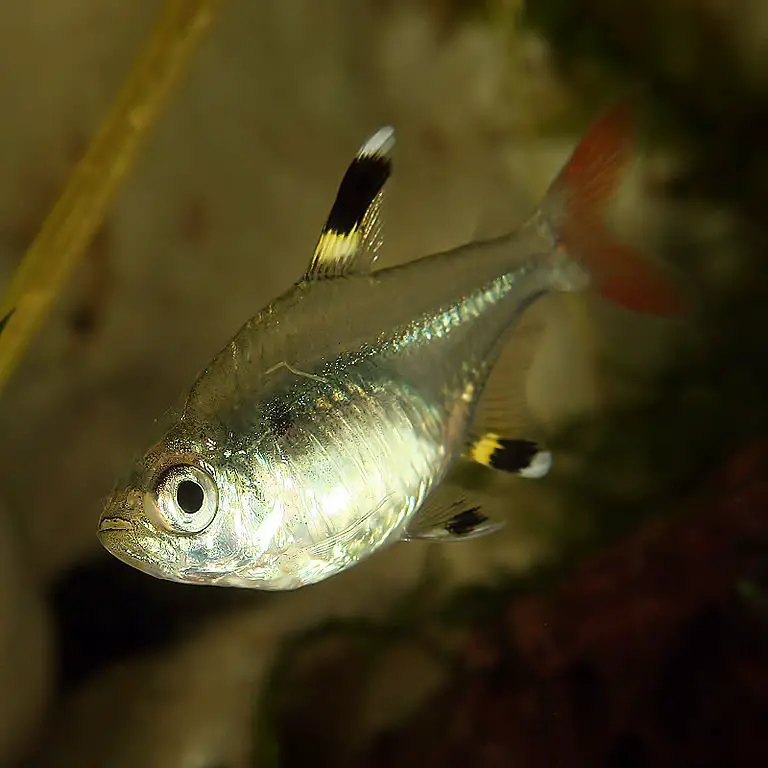Tetras are tiny, attractive freshwater fish of the characin family called Characidae. Tetras are very widely accepted as pets in home aquariums worldwide. The tetras are excellent community fish. Among different tetras, Buenos Aires tetra (Scientific Name: Hyphessobrycon anisitsi) is one of the hardiest tetra fish. This tetra does not require any special water keeping conditions.
The Buenos Aires tetras are quite large fish. With proper water conditions, the fish can live a healthy life. The qualities of this tetra make it easy for the beginning fish keepers to keep them in the aquarium. There are also the albino Buenos Aires tetras; however, these tetras are not very commonly available as their regular versions.
Most aquarists say that Buenos Aires tetras are fantastic species to watch. These fish are very active, although they do not get along with other species in the tank at first. Nevertheless, they will get along after adjusting to their tank. You will learn more in detail about this tetra in the article.
Let’s check it out.
Origin, Habitat in the Wild and Distribution
In 1907, an ichthyologist named Carl Henry Eigenmann described Buenos Aires tetras. Previously, tetra’s scientific name was Hyphessobrycon caudovittatis.
Buenos Aires tetra’s name comes from the capital city of Argentina. Hence, it is clear that the fish comes from the areas near the western shores of Rio de la Plata, South America, formed by joining the rivers Parana and Uruguay rivers. The tetras are also common in southeastern Brazil.
The tetras occur more frequently in smaller rivers and tributaries than in main river channels and are prevalent in backwaters and oxbows.
These tetras are active shoaling fish. In the wild, you can find such tetras in rivers, ponds, streams, and lakes. These tetras are not fond of salty or dirty water conditions. The IUCN Red List does not consist of this tetra.
About Buenos Aires Tetra
The Buenos Aires tetras are very beautiful. The tetras are very easy going and adapt to various water conditions. These fish were the most popular aquarium fish for many years. However, the tetras have been falling a bit in popularity, mainly because many people prefer live plants in their aquarium, and this tetra eats live plants.
If you do not have a problem with keeping artificial plants in your aquarium, then you will not have any problem with Buenos Aires Tetras.
Let us know more about this tetra in detail.
Fish Appearance
Compared to other tetras, the Buenos Aires tetras are larger fish. These fish can grow up to 7 to 8 cm in length (2.8 to 3 inches). Since this fish is quite large, they also have a big appetite.
The body of this tetra has colors of silver, white, black, brown, and olive on their anal and dorsal fins. The abdominal fins of these tetras are in reddish and yellow colors. The body has a silver color that is somewhat flashy with neon highlights.
A narrow blue line is present across the body, starting behind the gills and ending at the caudal fin. To add, the most exclusive feature that the fish has is the bold black cross shape in their caudal peduncle.
Availability
As I have mentioned earlier, the IUCN Red List has not listed this fish as an endangered species. Hence, these fish can be available in the wild as well. However, most of these tetras that pet stores offer to sell are bred commercially.
You can find the species bred commercially in fish farms, especially in the areas of Florida. The tetra’s price is reasonable and is available in many fish stores and online stores in various regions.
Price
Since the tetras are schooling fish, you need to purchase them in bulk, which is at least six fish. You need to buy the Buenos Aires tetras in groups as well. The group price for five or more fish is £1.91 per fish. This price range is across Europe. Across the USA, the price of this tetra fish maybe $1.89 per fish for groups of 5 or more.
Life Span
In the wild, the Buenos Aires tetras can live up to 5 years or even more. However, the lifespan of this tetra in captivity can be 3 to 5 years.
Sexual Difference
In tetra fish, you can distinguish between males and females by their coloration and their size. Most tetras are very hard to differentiate, and only an expert will be able to do so.
The sexually mature male Buenos Aires tetras are brighter in colors. This tetra has red fins, which looks more vibrant in male tetra. The males are comparatively smaller than the females as the females have larger and border abdomen. The rounder and big sized belly of the females helps them in storing the eggs during the spawning period.
Social Behavior and Tank Mates
Generally, tetras are very friendly and peaceful community fish. Buenos Aires tetra fish are relatively larger than other tetras, which can make the tetra a bit intimidating to other smaller species. The fact that these tetras can have a habit of nipping the fins of tank mates does not help. The fin nipping can mostly occur when you keep them with inadequate schools. This may also happen when they do not have enough space to swim in the tank.
Sometimes the tetras can form a social hierarchy among their school. The males within the group can clash with each other to grab the attention of the females. These fish are mostly kept in groups of more than six fish so that they are not distracted by other tank mates.
You need to research carefully before purchasing the tank mates for Buenos Aires tetra. These tetras are energetic, and a bit aggressive with slower fish and can compete with them for food. Hence, it is better to put them with the species that can match their behavior. Some of the suitable companions for this tetra are rainbowfish, larger rasboras, barbs, and danionins.
Fish Keeping Difficulty
Even though most tetras are hardy and suitable even for the beginner fish keepers. These tetras can adapt very well to the water parameters tank, easy to care for, and does not need any special conditions. These fish can easily thrive with good and stable water conditions and a tank environment.
Despite all these factors, you may face a minor inconvenience with these tetras when they start nipping other fish’s fins. As these tetras have a great appetite, you must constantly keep them well fed. If you feed the tetras well, there will be a decrease in the fin nipping.
If you are a fan of keeping live plants as decoration in your tank, there might be a small problem. The Buenos Aires tetras take the live plants as foods and eat them all. Therefore, you might need to keep artificial plants when you put these fish in your aquarium. The fish should be able to eat the food you provide within 3 to 5 minutes.
Caring for Buenos Aires Tetra
If you are thinking about purchasing fish, then you should know all the responsibilities that come with it. Fish pets are different from other pets, but they do require proper care, nurture, and a suitable living environment. Even though fish are quite less trouble than other animals, you should not neglect them as the fish live in a completely different environment from us. Their primary habitat consists of water. Just as we need fresh air to live and breathe, the fish also need clean waters and clean tanks. Hence, they are more dependent on us.
As a tetra owner, I can say that keeping fish is high maintenance, not in case of expense, but the fish’s care. Nonetheless, it can be easy if you have a good understanding of what the fish wants.
In this section of the article, I will provide you with all the information needed to give the Buenos Aires tetra the best possible care. Read further more information.
Tank Size
Tetras can thrive in the aquarium with proper maintenance. As Buenos Aires tetras are active shoaling fish, it is essential to have enough space for them to swim freely and play around with their school. Thus, the minimum size of the tank should be 25 gallons with base dimensions of at least 90 * 30 cm.
One thing you should understand is that it is easier to care for your fish when you keep them in a large aquarium. So, the bigger the aquarium, the better.
Lightings
The lighting plays a great role in bringing out the colors of the tetras. The lighting for the Buenos Aires tetras should be moderate to normal. The bright lighting in the tank can cause stress and bring out the aggressive nature. You need to create hiding spaces for the tetras.
Decorations and Substrate
The first step when you set up a tank is to add the decorations and substrate. So, you must be aware of the requirements needed in the tank before you put the fish.
These tetras take live plants as their food. Hence, it will be useless for you to add live plants to the tank as the fish easily destroys them. In place of the live plants, you can add artificial plants or Java fern plants as decoration. Other decorative items are driftwood and rocks.
For the part of the substrate, it is very easy because the fish goes well with any substrate working with normal lighting. So you can pick the substrate you like with the lighting you have.
Fish Diet
Like most of the tetras, Buenos Aires tetras are also omnivores. In the wild, they mostly feed on worms, crustaceans, insects as well as plants. In the aquarium, these tetras are easily pleased and are bold feeders. You must feed these tetras with a high-quality flake or granular foods. The supplement food for these fish can be live or frozen bloodworms, daphnia, glass worms, etc.
These fish also eat your aquarium plants, if you have any live plants. Other vegetarian items include sliced cucumber, blanched spinach, and nori. These diets can help them grow to their full potential as well make them healthy.
Maintain water quality
If you want to keep pet fish, the first thing you need to do is take time to maintain the water. Yes, it can take a little effort, but the result of it can provide the best rewards for your fish and you. You need to make sure that you understand the water chemistry before you purchase any kind of fish. You do not have to read the chemical formulas in detail. You just need to understand the basic and surface-level composition.
As the aquarium is a closed and isolated ecosystem, you can see the development of various impurities in the water. These impurities can cause the water to be toxins to the fish. Therefore, you need to test the aquarium water quality and avoid any kind of problem. Doing so will ensure your fresh good health and long life.
Let us look at the different ways that you need to follow to maintain the quality of water.
Water Temperature
The temperature is an essential factor that helps the fish to live a healthy life. Warm water can increase the fish’s metabolism and make the fish active. Another problem with very warm water is that it carries less oxygen in the water, making your fish suffocate. On the contrary, cold water can cause the fish to be passive and decrease their lifespan.
For Buenos Aires tetra, the temperature should be within the range of 16 to 28°C.
pH and Hardness
To maintain the pH level and the Hardness of water, you may use various toolkits that you can find in the pet stores or local marts. These kits are not hard to use, as you only need to dip them into your tank water.
This is important to maintain as the pH can determine the acidity of the water. The Hardness determines the various compounds and ions in the water. If you are planning to keep Buenos Aires tetra, you need to maintain the pH level in the range of 6 to 8. The Hardness of the water should be between 2 to 30 dGH.
Filtration
Installing a filtration system for your tank is quite beneficial. It enhances the quality of life for your fish as well as provides a helping hand for you. The filtration system can help you with the impurities that you are not able to clean, which includes removing the fragments of tiny plant materials, leftover food, feces, and other waste products.
The most common filters preferred by the aquarists are the biological filters and the chemical filters. The filters help in the nitrogen cycle where there is breaking down of unwanted chemicals such as ammonia, nitrites, etc. to less toxic nitrates.
However, you also need to clean up the filters from time to time as sometimes the filters can get clogged. Using filtration provides your fish tank with constant clean water.
Water Maintenance
Even if you get the best filtration system in your tank, it is necessary to monitor the changes occurring in the tank. The water in your tank can change colors, and there can be the development of unwanted materials. Hence, for the aquarium to function properly and the fish to become healthy, you need to change the tank water. You should change the tank water by 10% to 20% every week.
The nitrogen cycle of the tank should be able to function properly, which can happen if there is a proper amount of minerals and proper compositions in the water. For the nitrogen cycle to function properly, there must be the growth of different bacteria such as Nitrosomonas and Nitrobacter. These bacterias are present in the substrate and other decorations as well. These bacterias break down the toxins such as ammonia, nitrates, and phosphates and convert them to nitrates.
Fish Diseases
You can take all the precautions you need for your fish; even then, they are prone to the diseases. When you sense any fish affected by some kind of disease, you need to take action immediately. If you can remove the diseased fish quickly from the tank, you can stop outbreaks and cure the fish.
Some of the common diseases that can occur in Buenos Aires tetras are skin flukes, parasitic infestations, ichthyobodo infection, and bacterial infections and diseases. You can prevent these diseases by taking care of the plants and decorative items that you keep in the tank. You can also feed them a healthy diet.
Breeding the fish
The Buenos Aires tetras are one of the easiest tetras to breed. All you need is to take care of some factors that help in breeding these tetras.
You can start by setting a separate aquarium for the spawning period. The water should only be softly acidic, with pH levels 6.5 to 7.2. The temperature of the water also should be around 24°C. You also need to use a small, air-powered sponge filter for water movement and filtration.
The breeding of the fish can be by keeping the fish in a pair or small groups. You need to condition the breeder fish with good foods. You should transfer the breeder fish into the tank in the evening as they spawn in the dawn. The females can lay up 2000 eggs. The female tetras deposit the eggs in plants and green floss.
After spawning, you have to remove the parents as these tetras tend to eat their eggs. The eggs will hatch in 24 to 36 hours. The newly born fry will swim after 4 to 6 days. You need to care properly for the fry and should consider a proper diet. The diet for the fry can be a micro worm or brine shrimp nauplii.
Conclusion
I hope that you can provide your fish with all the required care by following the points mentioned in this article. Hoping that this article has helped you understand the precautions and the steps you need to perform if you want to keep the pet fish.
We have more articles regarding other tetras that are compatible together in the tank. See our other articles for more information in detail.
